#circular textile
Text
Textile entrepreneur Julie Lietaer: 'As a statement I always wear the same dress when I speech'

Since she took over from her father in the family textile company, she has been fully committed to sustainability. That is a challenge now that the industry is being hit hard. Breakfast with De Tijd.
“My daughter has prepared everything there in that corner,” says Julie Lietaer (40) jokingly[1], pointing to her daughter's toy kitchen in the corner. But on the beautifully laid table in her house in Kortrijk[2] there is no plastic fruit or bread from that kitchen, but there are fresh rolls, all kinds of toppings, squeezed orange juice, yogurt and berries. “Going to get it especially for you, because it's usually a bit more austere here.”
Lietaer follows the rules of The 5 AM Club,[3] whereby you exercise for half an hour early in the morning and read or meditate for half an hour. "It also gives me some me-time before the children wake up." She has recently used the peace and quiet to keep many balls in the air at the same time: managing the yarn producer European Spinning Group, chairing the sustainability platform Ariadne Innovation[4] and her many lectures and efforts to put the textile sector and industry on the green path. She is also on the jury of Changemakers, the sustainability awards that the Belgian newspapers De Tijd and L'Echo are presenting for the first time this year.
Convincing entrepreneurs to change course has become more difficult recently, Lietaer admits. The industry is not having an easy time. 'Many factors are pushing the manufacturing industry to its limits: labour costs, energy prices, finding suitable staff. All basic foundations are very difficult at the moment. That is no different for us. And we are already coming out of a difficult period. When I took over from my father two years ago, I immediately had the corona and energy crisis on my plate.'
European Spinning Group[5] sells yarns used for weaving and knitting carpets, clothing, decorative and outdoor fabrics and technical textiles. This can be polyester, acrylic, cotton or viscose. The company has a turnover of 32 million euros and employs ninety people. 'As a raw material producer, we are often at the front of the chain. There have been some slight improvements, but the foundations are completely wrong.'

There is still fire in her eyes when she talks about the importance of sustainability in the textile sector, although she admits that it is becoming increasingly difficult. 'When I go to speak, I feel that people for whom sustainability is not really in their DNA are now pushing those beautiful principles aside.'
In her own company, Lietaer labels 30 percent of production as sustainable, but she points out that there is an urgent need for clearly defined criteria, such as in organic agriculture, to prevent greenwashing. 'Initially we aim for recycled or circular products. But it could just as easily be about a more sustainable type of cotton, flax, hemp and recycled materials. Or about raw materials that we no longer have to colour, so we need less water or chemical processing during the production process.'
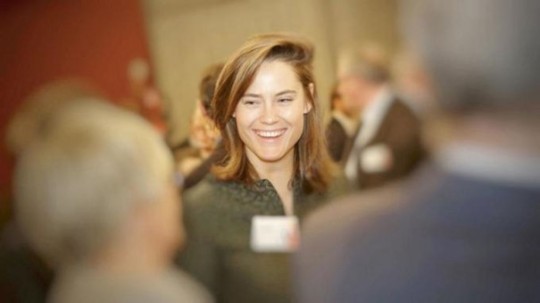
Julie Lietaer
When Lietaer arrives at the company in Spiere-Helkijn after her morning rituals and time with the family, she likes to first walk through the factory, touch the yarns and chat with the workers. 'The people on the floor also read and hear that companies are restructuring and going bankrupt, and they are becoming insecure. As a manager and entrepreneur you have the difficult task of providing stability in this area. Of course, you shouldn't make silly choices at that moment that suddenly make your business model 200 percent more expensive.'
She believes it is no reason to give up on sustainability. 'What you should not do is to put your long-term vision on hold because things are difficult now. That is a balance that you must continuously strive for as an entrepreneur. Sustainability should be inherent in business operations, because it prepares you for the future and creates your own market segment where people are willing to pay a little more.'
Is that the case when it comes to clothing and textiles? Young people are willing to fly less and eat vegetarian, but do they look at the label of trendy clothing to see if it is made from recycled fabrics?
And not everyone can afford the flax tablecloth with custom napkins on which this breakfast is served. Lietaer says she is not so pessimistic after all. 'Many young consumers buy second-hand clothing. Online via sites such as Vinted[6], but the growth of thrift stores is also enormous.[7] And there really is a market of consumers who are willing to spend a little more, knowing that their products will also last longer.'
She does admit that things are going slower than hoped. 'When I go to speak somewhere, I often wear the same green dress. I received comments about this on my Instagram account: "Is she wearing the same thing again?" Fast media leads to the creation of fast fashion.[8] Because people expect that if you post something every day, it will be with a different outfit every time. That's why I now stubbornly always wear that same dress!'
With her start-up Ariadne Innovation, Lietaer wants to inspire and inform other companies about sustainability. 'I call it the Tinder for textiles. We have developed a software platform to connect companies, because the entire ecosystem of the circular economy is new for textile companies. The start-up is quite slow but steady. We now have 650 users. This includes both textile companies and social economy companies. We have educational institutions, machine manufacturers, software builders, fashion brands and retailers in the network.'
Remarkable: as an entrepreneur, Lietaer is not averse to additional government regulations. “As long as it doesn't interfere with everything,” she says. “I don't want her to come check me out for everything I do on my production floor. But I believe in initiatives such as the product passport, which requires manufacturers to provide more information about sustainability and origin in addition to the composition of the clothing. Europe's Green Deal is also a good thing.'
Many business leaders say Europe is shooting itself in the foot by trying to move too fast. If you impose too many rules on a factory here, for example on emissions, then that factory will simply move outside Europe, where it is much more polluting, is an often-heard argument. 'If we don't get the fundamental industrial competitiveness right, we can't actually start making things more sustainable. That's right. But I do believe that we are moving towards a level playing field, where polluting products will be taxed at our borders.'
The company logo contains a dove. It is a reference to Lietaer's grandfather, who was often in Asia as a pigeon breeder and came in contact with a manufacturer of yarn in Taiwan, which he started importing. His granddaughter also knows Asia well. 'We always speak of Europe as a pioneer in sustainability, but I think many would be shocked if they went to India or China. It is amazing what developments are already underway there in the circular economy and recycling. If Europe doesn't move up a gear, they will simply overtake us, just as you see happening now in the world of electric cars.'
She has few good words to say about domestic political policy. 'As a young entrepreneur in the industry, you find support from your employees and from family, friends and other entrepreneurs. But the politicians just seem to ignore us. You only get some attention if you are in biotech or something like that.'
'I conclude that the traditional industries, that have created many jobs in our country for a hundred or two hundred years and that are in the process of reinventing themselves, are not important. I really don't know what our political strategy currently stands for, and I therefore find it extremely difficult to decide who I will vote for. And I assume that many entrepreneurs share that opinion. I just don't know anymore.'
Despite this disappointment and the difficult economic conditions, she refuses to become defeatist. 'That is typical for an entrepreneur: you see solutions everywhere. As a new generation in a family business, you are a kind of steward for the next generation. You don't necessarily own the company, you transfer it. Ideally, you should see it that way for society as well. Of course, you can also stay in bed all day, watch Netflix and think that the world around you doesn't exist, but that's not in my DNA. There is simply no other choice.”
Source
Henk Dheedene, Textielonderneemster Julie Lietaer: ‘Als statement draag ik altijd dezelfde jurk bij een toespraak’, in: De Tijd, 03-11-2023 https://www.tijd.be/dossier/ontbijt/textielonderneemster-julie-lietaer-als-statement-draag-ik-altijd-dezelfde-jurk-bij-een-toespraak/10503837.html
[1] Read also: https://www.tumblr.com/earaercircular/653321265697947648/textile-entrepreneur-julie-lietaer-we-wont-make?source=share&ref=_tumblr
[2] Kortrijk (French: Courtrai), is a Belgian city and municipality in the Flemish province of West Flanders. With its 79,000 inhabitants (2023) Kortrijk is the capital and largest city of the judicial and administrative arrondissement of Kortrijk. The city is on the river Leie, 42 km southwest of Ghent and 25 km northeast of Lille. Mouscron in Wallonia is just south of Courtrai.
[3] Legendary leadership and elite performance expert Robin Sharma introduced the 5am Club concept over twenty years ago, based on a revolutionary morning routine that has helped his clients maximize their productivity, activate their best health and bulletproof their serenity in this age of overwhelming complexity.
[4] Ariadne believes that the future of the textile & fashion industry focuses on 3 pillars: Sustainability, Collaboration, Digitalisation. Each pillar is associated with social and individual challenges. By means of a close and open cooperation and by offering the right digital technologies Ariadne wants to support you to make this shift possible. https://www.ariadne-innovation.com/about-us
[5] European Spinning Group is a Group of textile companies in Spiere-Helkijn, West Flanders. It was founded in 1972 from the import company Symaco by André Lietaer, the grandfather of Julie Lietaer. Her father added the yarn manufacturers AVS and Sigma Spinning. It produces and distributes yarns for the production of interior fabrics, clothing and technical textiles and has a turnover of 25 million euros. It employs 95 people.
[6] Read also https://www.tumblr.com/earaercircular/651419252492009472/capital-injection-vinted-250-million-euros-for?source=share&ref=_tumblr
[7] Read also: https://www.tumblr.com/earaercircular/716134244688232448/the-danish-red-cross-made-100-million-from-its?source=share&ref=_tumblr & https://www.tumblr.com/earaercircular/651509379878813696/second-hand-economy-much-bigger-than-expected?source=share&ref=_tumblr
[8] Read also: https://www.tumblr.com/earaercircular/650458804870414336/second-hand-good-for-climate-and-employment?source=share&ref=_tumblr & https://www.tumblr.com/earaercircular/730359554901180416/patagonia-circular-fashion-and-commitment-to-the?source=share&ref=_tumblr
1 note
·
View note
Text
youtube
Every year, nearly 100 billion items of clothing are produced – and 65% of them end up in a landfill within 12 months. New technologies in textile recycling may be able to curb that waste – while producing a host of sustainable materials.
#planeta #recycling #fastfashion #circulareconomy #textileindustry
We're destroying our environment at an alarming rate. But it doesn't need to be this way. Our new channel Planet A explores the shift towards an eco-friendly world — and challenges our ideas about what dealing with climate change means. We look at the big and the small: What we can do and how the system needs to change. Every Friday we'll take a truly global look at how to get us out of this mess.
Follow Planet A on TikTok: https://www.tiktok.com/@dw_planeta?la...
Credits:
Report: Dave Braneck
Video Editor: Frederik Willmann
Supervising Editor: Michael Trobridge
Fact Check: Alexander Paquet
Thumbnail: Ém Chabridon
Read More:
McKinsey - Scaling Textile Recycling in Europe
https://www.mckinsey.com/industries/r...
NY Times - Will We Ever Be Able to Recycle Our Clothes Like an Aluminum Can?
https://www.nytimes.com/2022/11/30/st...
EU Strategy for Sustainable and Circular Textiles https://environment.ec.europa.eu/stra...
Chapters:
00:00 Intro
00:46 Textile waste's global impact
02:47 How do you actually recycle clothes?
03:50 New approaches to textile recycling
07:41 What else needs solving?
11:41 Can we even recycle all the clothes we make?
#DW Planet A#solarpunk#fashion#fashion industry#fast fashion#fashion waste#circular fashion#recycling#textiles#textile industry#sustainable fashion#sustainable textiles#textile recycling#Youtube
6 notes
·
View notes
Text
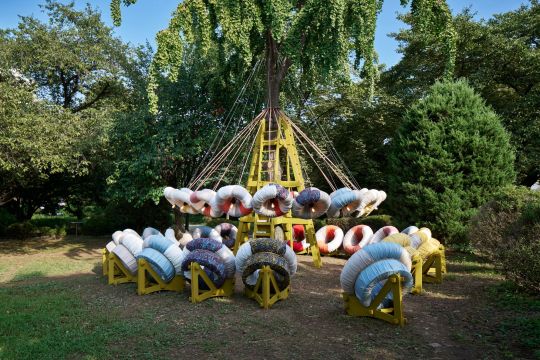






Bojagi Lounge, Anyang, Gyeonggi province, South Korea,
"ZONE 7: Your Imaginary Space," Anyang Public Art Project (APAP),
Izaskun Chinchilla Art,
Photograph by DongWoong Lee
#art#design#outdoor#lounge#bojagi#south korea#anyang#zonz7#APAP#izaskun chinchilla#sunbrella#fabric#textile#installation#circular economy#household economy#doughnuts#norigae
13 notes
·
View notes
Text
4R'S: CIRCULAR ECONOMY & ZERO WASTE EDUCATIONAL TOOLKITS
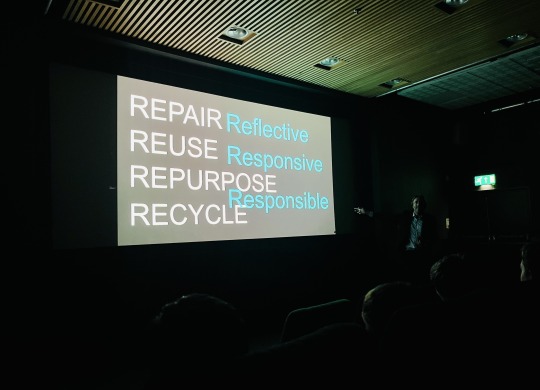
Arts University Plymouth leads the development of educational toolkits for teaching zero waste principles to primary, secondary and college level students in Finland, Turkey, England and Spain.
As part of the Erasmus+ funded project development, sharing rights of all images have been granted by the working partners at each educational institution.

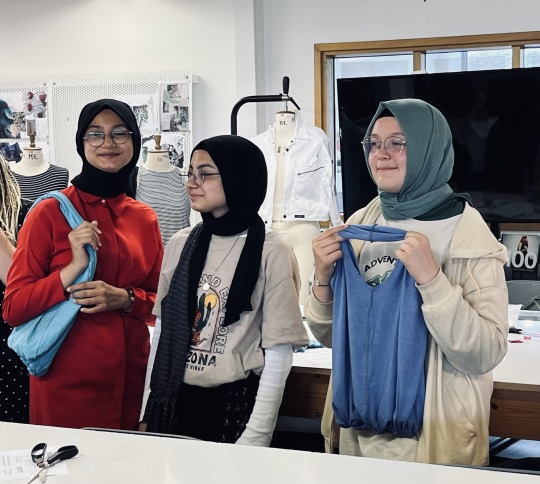

#circular economy#zero waste#design#textiles#closed loop#sustainable design#international exchange#arts education
0 notes
Text
Moda Sostenible: La Revolución del Nailon Reciclado
¡Hola emprendedores! Hoy traemos noticias frescas que no solo impactan en el mundo de la moda, sino también en la sostenibilidad y la economía circular. BASF e Inditex se unen para presentar una innovadora solución que promete revolucionar la industria textil: prendas de nailon fabricadas completamente a partir de residuos textiles.
Este avance no solo demuestra un compromiso con el medio…
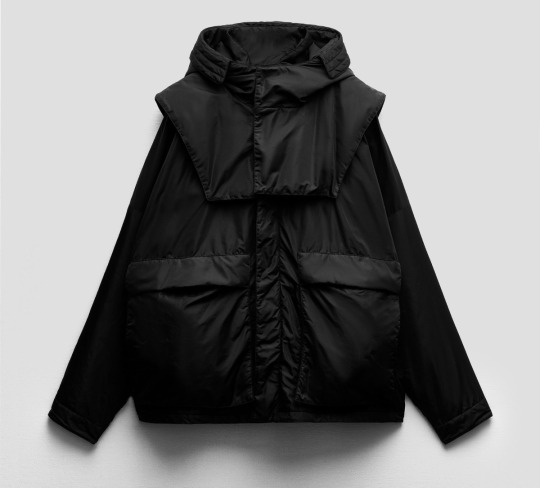
View On WordPress
#Basf#economía circular#Inditex#industria de la moda#innovación textil#loopamid#moda sostenible#nailon reciclado#prendas recicladas#sustentabilidad
1 note
·
View note
Text
Types of Circular Knitting Machine

Single Jersey Knitting Machine
This machine has a single cylinder, and the diameter of the cylinder is around 30 inches. The thickness of the fabric made out of it is comparatively less than the double jersey knitting machine. Wool production on this machine is limited to 20 gauge. Plain fabric has been made since the invention of knitting. Plain fabric can be made with both hand and machinery. We can use plain fabric in manufacturing various garments such as t-shirts, blouses, tops and casual dresses. This machine has needle fed vertically and the knitting is done only in one direction. Sinkers play an important part in making the loops for knitting. The fabric made out of this machine has curling ends.
Advantages Of Single Jersey Knitting Machine
A- This machine is a good choice for mass production
B- This machine can manufacture a variety of products from lightweight to heavy-weight fabric.
C- Single jersey machine is easy to maintain and repair
D- Less expensive compared to double jersey knitting machine ]
E- It can switch between colors easily
Double Jersey Knitting Machine
A double jersey knitting machine is a single jersey knitting machine only. There is one additional dial that is equipped with needles that move horizontally adjacent to the vertical needles. The extra needles help in making the thicker fabric. This machine knits in 2 directions perpendicular to each other. Sinkers are not required in this machine as there are 2 sets of needles that coordinate to knot the fabric. The garments that are made out of the end product of this machine are hoodies, sweatshirts, layettes and high-end t-shirts. The end product does not curl, unlike in a single jersey knitting machine.
Advantages Of Double Jersey Knitting Machine
A- Can produce fabric with different textures such as terry and pique
B- It can produce multiple patterns, such as stripes and jacquards
C- It can produce thicker fabric with higher insulated properties
Originally Written by catcheyes, buy t-shirts in bulk
1 note
·
View note
Link
What is EPR/PRO? In certain government jurisdictions, producers must comply with EPR requirements for items. This is to promote proper recycling and extensive sustainable recycling for certain materials. Producer organizations must file EPR returns annually. An EPR return for waste is just like ITR or Income Tax Return. As a producer, they must file an
#White-Labelled Csr Solutions#Circular economy in Dubai#Global circle recycling in Dubai#Secure Destruction services in Dubai#Innovative Circular Economy Solutions in Dubai#Textile Waste Recycling Services Dubai#Brand Protection in Dubai#Aerosol Recycling services in dubai#Hazardous Waste Collection#Cosmetics Recycling Service in Dubai#Recycling Zero Waste Solutions#Consumer Goods recycling in Dubai#Community recycling solutions
0 notes
Text
National Institute of Textile Engineering and Research (Knitter) Job Circular
National Institute of Textile Engineering and Research (Knitter) Job Circular
If you are on the lookout for new government job opportunities in Bangladesh, then you have come to the right place. The National Institute of Textile Engineering and Research (Knitter) New Govt Job Circular BD is here to provide you with the latest updates on job vacancies in the government sector. In this blog post,…

View On WordPress
#Govt job#Govt Job Circular#Govt Job Circular 2023#Govt Job circular BD#Job Circular#National Institute of Textile Engineering and Research (Knitter) Job Circular#new Govt Job
0 notes
Text
La revolución verde de la moda: la sostenibilidad ocupa un lugar central en la industria textil
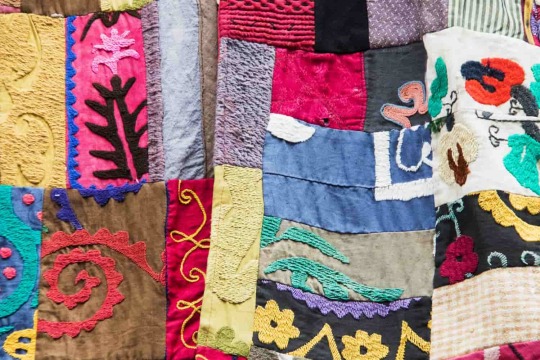
La industria de la moda, conocida por su impacto ambiental, ahora está experimentando un cambio transformador hacia la sostenibilidad. Con la creciente preocupación por la huella ecológica de la industria textil, la moda sostenible se perfila como una solución clave.
Exploremos en este artículo cómo este movimiento está revolucionando la industria, desde prácticas ecológicas hasta moda circular, y descubra cómo los consumidores y las partes interesadas de la industria están impulsando el cambio hacia un futuro más verde.
Moda sostenible: Allanando el camino hacia una industria textil más ecológica
La industria textil desempeña un papel importante en nuestras vidas, ya que nos proporciona prendas de vestir, accesorios y textiles para diversos fines.
Sin embargo, no podemos ignorar su impacto en el medio ambiente. A medida que crece la preocupación por la sostenibilidad, la industria de la moda está empezando a introducir cambios importantes para minimizar su huella ecológica.
En este artículo exploraremos el concepto de moda sostenible y su potencial para revolucionar la industria textil.
El reto medioambiental
La industria textil ha estado tradicionalmente asociada a problemas medioambientales debido a su elevado consumo de agua, la contaminación química y las altas emisiones de carbono.
Desde el cultivo de materias primas hasta los procesos de fabricación y la gestión de residuos, cada paso de la cadena de producción textil tiene implicaciones para nuestro planeta.
Sin embargo, la moda sostenible pretende abordar estos retos y crear una industria más respetuosa con el medio ambiente.
Adoptar la sostenibilidad
En los últimos años se ha producido un cambio significativo hacia la sostenibilidad en el mundo de la moda.
Las marcas están adoptando prácticas respetuosas con el medio ambiente, como el uso de materiales orgánicos y reciclados, la reducción del consumo de agua y la aplicación de procesos de fabricación más limpios.
Al dar prioridad al abastecimiento sostenible, las prácticas laborales éticas y la reducción de residuos, las empresas de moda están empezando a adoptar un enfoque más consciente del medio ambiente.
Moda circular
Uno de los conceptos clave de la moda sostenible es la idea de circularidad. En lugar del modelo lineal tradicional de «tomar, hacer y tirar», la moda circular promueve un sistema de circuito cerrado.
Esto significa diseñar los productos pensando en la longevidad, fomentar la reutilización y el reciclaje, y minimizar los residuos a lo largo del ciclo de vida de una prenda.
Desde los servicios de alquiler de ropa hasta las iniciativas de upcycling, están surgiendo enfoques innovadores para prolongar la vida útil de los artículos de moda y reducir su impacto ambiental.
El poder del consumidor
Los consumidores también desempeñan un papel crucial a la hora de impulsar la sostenibilidad en la industria de la moda.
A medida que aumenta la concienciación, las personas son más conscientes de sus decisiones de compra.
Buscan marcas que se alineen con sus valores y ofrezcan opciones sostenibles.
Al apoyar a las marcas de moda ecológicas y exigir transparencia a los fabricantes, los consumidores pueden contribuir activamente al cambio hacia una industria textil más ecológica.
Colaboración e innovación
Lograr una industria de la moda verdaderamente sostenible requiere colaboración e innovación en todos los ámbitos.
Diseñadores, fabricantes, responsables políticos y consumidores deben trabajar juntos para encontrar soluciones creativas y aplicar prácticas sostenibles.
Esto incluye invertir en investigación y desarrollo de materiales respetuosos con el medio ambiente, explorar nuevas técnicas de fabricación y establecer normativas más estrictas para minimizar el impacto ambiental de la industria.
La industria de la moda se encuentra en un punto de inflexión en el que la sostenibilidad ya no es una opción, sino una necesidad.
Al adoptar prácticas sostenibles, la industria textil puede reducir su huella medioambiental y crear un futuro más responsable y ético.
A través de la moda circular, la concienciación de los consumidores y los esfuerzos de colaboración, podemos allanar el camino hacia una industria de la moda más ecológica y sostenible que beneficie tanto a nuestro planeta como a las generaciones futuras.
Originally published at http://accionbiodiversidadblog.com/ May 22, 2023.
0 notes
Text

#sustainable#3d#circularfashion#circularism#techpacks#pattern#digital patterns#crafts#textile#yarn#ethicalclothing#ethicallysourced#knits#fashion designing#fashion illustration#digital illustration#ondemand#apparelmanufacturer#tshirts#womenfashion#menswear#womenclothing#mensclothing#kidswear#baby clothing manufacturers#activewearmanufactureruk#private label activewear#custom activewear manufacturers#custommade#bespoke
0 notes
Text
Success with the recyclable membrane

The company Sympatex from Unterföhring in Bavaria, Germany wants to show that sustainable textile management works. Environmental technology should bring growth.
It is transparent, feels a bit like cling film and is paper thin. The membrane from Sympatex Technologies GmbH[1] from Unterföhring[2] can be found in many outdoor clothing items and shoes. Although it is hardly visible, it has a major impact: it makes products waterproof, breathable and fully recyclable. It is also part of a mission. Because managing director Rüdiger Fox wants to show with it and his company that a sustainable clothing industry is possible. "We want to accelerate change in the textile industry and prove that sustainability is a recipe for success."
A few examples of laminate are laid out on the large conference table in the company on the Feringastraße, which extends over two floors in a commercial building and a laboratory in the basement. The membrane is glued between two layers of fabric. These laminates are then used, for example, in clothing from the company Vaude[3] or children's shoes from the Ricosta[4] brand. According to Sympatex, it works with around 100 brands and partners. What is special about the membrane: it is made of polyester. It is bonded to fabrics, also made of polyester, to form a laminate. "Because it is a mono-material, the membrane and the laminate can be easily recycled," says Fox, citing the advantage. It is therefore not necessary to separate several components.
Fox compares the membrane to the skin: it prevents water from coming through the clothing from the outside and allows sweat to escape to the outside. The more moisture has to be transported, the more breathable it becomes. The function is particularly appreciated for sports that take place in the snow, says the 56-year-old. Fox does not want to reveal how many people are employed at Sympatex. "We are a medium-sized company," he says. There are various departments at the company headquarters in Unterföhring, from marketing to development. The company produces in China, France and the USA, among other places.
The beginnings 35 years ago
The company was founded about 35 years ago as a spin-off[5] of a chemical company with the membrane as its core product. When Fox, who is an aerospace engineer and business economist and has a doctorate in communication sciences, took over the company in 2016, he first asked the team: What does the world need us for and what makes us special? According to him, his idea from the start was to consider how clothing could be produced as ecologically as possible. He believes that if you can make a difference, you should also take responsibility: in his case for a clean environment and for everyone who comes after us. He himself has four children. Finally, he and the workforce made the decision: "We put economic success behind the idea of sustainability," he says. This is a bold statement at first, but it seems to be working. "This year we have a growth of 30 percent." But Fox admits it wasn't easy work, and he didn't expect it would take five years for the message to get through to customers.
A central aspect of the company’s philosophy is to align the strategy with the customer towards circularity. In summary, to produce in a closed cycle by reusing old products in the manufacture and generating as little waste as possible, among other things by the partners also working with mono-materials. Sympatex has set itself the goal of 100 percent circular production by 2030. The company tinkers and tests a lot, including in the laboratory in the basement, where, among other things, the waterproofness of the laminates is checked. In 2019, for example, the company presented a jacket that it had made from old material. A jacket was shredded, yarn makers turned it back into yarn, and the result was a greyish garment. "It's not perfect yet, it needs to be developed further, but we wanted to show that it's possible," says Fox.
Part of the company's idea of sustainability is that it wants to keep its own CO₂ footprint as small as possible. "80 to 90 percent of CO₂ is generated in our supply chain," says Fox. Therefore, the company has started to reduce the materials even more. A third point: the fluorine chemistry should be eliminated from the manufacturing processes. "This is a man-made synthetic that's extremely water-repellent, but it's never going to disappear from the face of the earth," says Fox. Greenpeace has detected the substance in polar bears. According to the Federal Environment Agency[6], perfluorinated and polyfluorinated chemicals (PFC) are used as additives in the production of the polymer PTFE, from which the membranes of some other manufacturers are made, so that traces of these compounds can be contained in the finished product. "In our membrane, they do not and never have existed," says Fox. However, they would have used the substance to impregnate the end product. Already a few years ago they had started to switch to bio-based impregnations and had almost completed it. Bio-based impregnations are just not quite as dirt-repellent.
The business card says "environmental activist"
For Fox, however, the question also arises as to what means an industry can use to keep its performance promises. "If a plane doesn't fly, it might crash and someone die. If our product isn't completely rainproof, someone will get wet. That can't justify using this chemistry for it," says Fox, proposing on his business card not only Managing Director, but also "Chief Environmental Activist". "As an industry, we have to ask ourselves new questions," he says.
Is it difficult to assert oneself against big players in the market? Fox sees the question relatively calmly. "Competition is competition." In any case, as he insists, it's more about the big picture, the changes towards a sustainable textile industry.
In spring, the EU published a strategy for sustainable and recyclable textiles[7]. The goals of Sympatex can be found there: by 2030, the EU Commission wants to achieve, among other things, that all textile products on the EU market are durable, can be repaired and recycled, consist largely of recycled fibres and are free of hazardous substances. Sympatex had positioned itself accordingly in advance, including a statement, as reported by Fox. According to its own statements, the company acts as a mouthpiece for the EU Commission and unites the clothing and shoe industry behind it with the aim of creating a political framework that accelerates the transformation of the industry towards the circular economy. So it works. Fox is confident: "We want to contribute on the business case: if we can do it, so can everyone else."
Source
Daniela Bode, Mit der recycelbaren Membran zum Erfolg, in: Süddeutsche Zeitung, 6-01-2023;
[1] Sympatex Technologies has been one of the world's leading suppliers of high-tech functional materials in clothing, shoes, accessories, workwear (contract & workwear) and technical applications since 1986. Sympatex is represented in over 20 countries and has its headquarters in Munich/Unterföhring. Together with selected partners, Sympatex develops, produces and sells membranes, laminates, functional textiles as well as finished products and customer-specific end products in the respective areas of application. https://www.sympatex.com/en/membran/
[2] Unterföhring is a municipality in Upper Bavaria. It lies adjacent to the northeast side of Munich, and is one of the nearest suburbs to Munich's central district.
[3] VAUDE is a German producer of mountain sports equipment. The head office is in Tettnang, Germany. It was founded in 1974 by Albrecht von Dewitz. The name of the firm is derived from the initials of its founder (V, D). The company is 100 percent family owned. In 2009, the management was handed over to his daughter Antje von Dewitz. Products include tents, backpacks, and sleeping bags. There are 486 employees working in the head office in Germany. The corporate group also owns production facilities in Bỉm Sơn, Vietnam. https://www.vaude.com/en-GB#
[4] For more than 45 years we have been developing and manufacturing the very best children's shoes with a lot of passion. Today, RICOSTA with its second brand PEPINO - the little fine ones - is not only one of the most successful, but also one of the most popular children's shoe brands - and that beyond the borders of Germany. This shows that a good fit, great wearing properties, convincing design and, last but not least, high-quality workmanship are still valued when it comes to children's shoes. And confirms that we do our best every day. https://www.ricosta.de/unternehmen
[5] a spin-off as a separate company
[6] The Umweltbundesamt (UBA) is the German Environment Agency. The headquarters are in Dessau-Roßlau. It was founded in Berlin in 1974 and is Germany's main environmental agency. In 2005, the agency moved to Dessau in Saxony-Anhalt. Together with the Bundesamt für Naturschutz, the Bundesamt für kerntechnische Entsorgungssicherheit and the Bundesamt für Strahlenschutz, it operates under the jurisdiction of the Federal Ministry of the Environment, Nature Conservation, and Nuclear Safety. The UBA's spectrum of issues includes all aspects of human activity on the biophysical environment. https://www.umweltbundesamt.de/en/the-uba/about-us
[7] The new strategy sets out the vision and concrete actions to ensure that by 2030 textile products placed on the EU market are long-lived and recyclable, made as much as possible of recycled fibres, free of hazardous substances and produced in respect of social rights and the environment. https://www.interregeurope.eu/news-and-events/news/new-eu-strategy-for-sustainable-and-circular-textiles
0 notes
Photo

Cautati agatatori plastic ? Va oferim o gama variata de agatatori plastic pentru atasarea etichetelor de pret pe produsele Dumneavoastra
#agatatori#plastic#circulare#pin#loop-pin#loop pin#agatatori etichete#snur#snur etichete#pret#textile#croitori#croitor#confectii textile#fashion#moda#mode#apparel
0 notes
Text

sweater made from human hair (source: Human Material Loop)
0 notes
Text

#headphones#round#circular#bright#electronics#textiles#audio#fabric#white#metal#frame#pipe#slider#button#arm#connection#melange#dvala#engrave#logo#soft#soft shape
0 notes
Text
Ecomondo “SwitchMed Connect”, the European Union’s circular economy event, in Italy for the first time
Ecomondo “SwitchMed Connect”, the European Union’s circular economy event, in Italy for the first time
Focus on the Blue Economy with #EYESONBLUE, the award ceremony for the most innovative projects for water issues and the conference on fish food systems
Ecomondo, an international reference for the circular economy. “This year,” announces Corrado Peraboni, CEO of IEG, “the Italian Exhibition Group show, scheduled from 8th to 11th November at Rimini Expo Centre will be hosting “SwitchMed Connect”…

View On WordPress
#access to sustainable finance#Blue Economy#Blue Economy in the Mediterranean#circular fish food systems#circularity of plastics#ECOMONDO#open-eco innovation#sustainable#SwitchMed:#textile and fashion industry#the circular economy
0 notes